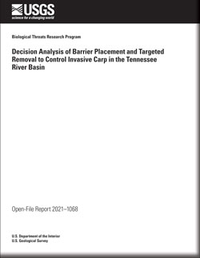Decision Analysis of Barrier Placement and Targeted Removal to Control Invasive Carp in the Tennessee River Basin
Links
- Document: Report (979 kB pdf)
- Download citation as: RIS | Dublin Core
Abstract
Controlling range expansion of invasive carp (specifically Hypophthalmichthys spp.) on the Tennessee River is important to conserve the ecological and economic benefits provided by the river. We collaborated with State and Federal agencies (the stakeholder group) to develop a decision framework and decision support model to evaluate strategies to control carp expansion in the Tennessee River. Using this decision framework, we assessed the efficacy of various barrier strategies (technologies and locations) on reducing bigheaded carp (Hypophthalmichthys nobilis [bighead carp] and Hypophthalmichthys molitrix [silver carp]) relative abundance under different patterns and magnitudes of population growth and movement. We also assessed whether or not these strategies induced tradeoffs between reducing bigheaded carp relative abundance and other considerations for public satisfaction, effects on lock operation, and native species. For the purpose of comparing options to control carp in a quantitative framework, we codeveloped a carp population dynamics model with the stakeholder group. We then used the model to compare invasive carp management options within the Tennessee River system. The actions we considered included barrier placement at lock and dam systems and targeted removal through harvest, which were believed to impede upstream carp spread and establishment. To account for the uncertainty in carp population growth and movement rates, the group developed four population models that varied in the underlying population dynamics and population growth rates. The models affected population growth through either the stock-recruitment relation or intrinsic density-dependent growth rate. We then tasked the stakeholder group to test various strategies using the model. We then developed a more formal optimization framework and solved for strategies that performed well under scenarios of barrier effectiveness, movement rate, recruitment frequency, fishing mortality, and variation in population growth rate. The results of our qualitative and quantitative analyses indicated that strategies designed to first protect reservoirs just above the leading edge of carp invasion by installing barriers and removing fish below that point would perform best; however, this depended on barrier effectiveness. When barrier effectiveness was high, simply cutting off the presumed source of carp and blocking the leading the edge was enough to stop carp invasion; however, lower effectiveness meant that more barriers would be needed to slow, but not completely stop, carp invasion. We discuss what these findings mean in terms of future monitoring and management efforts to reduce the potential for expanding carp invasion.
Suggested Citation
Post van der Burg, M., Smith, D.R., Cupp, A.R., Rogers, M.W., and Chapman, D.C., 2021, Decision analysis of barrier placement and targeted removal to control invasive carp in the Tennessee River Basin: U.S. Geological Survey Open-File Report 2021–1068, 18 p., https://doi.org/10.3133/ofr20211068.
ISSN: 2331-1258 (online)
Study Area
Table of Contents
- Acknowledgments
- Abstract
- Introduction
- Study Site
- Decision-Analysis Process
- Results
- Insights and Discussion
- References Cited
| Publication type | Report |
|---|---|
| Publication Subtype | USGS Numbered Series |
| Title | Decision analysis of barrier placement and targeted removal to control invasive carp in the Tennessee River Basin |
| Series title | Open-File Report |
| Series number | 2021-1068 |
| DOI | 10.3133/ofr20211068 |
| Publication Date | June 15, 2021 |
| Year Published | 2021 |
| Language | English |
| Publisher | U.S. Geological Survey |
| Publisher location | Reston, VA |
| Contributing office(s) | Columbia Environmental Research Center, Coop Res Unit Atlanta, Leetown Science Center, Northern Prairie Wildlife Research Center, Upper Midwest Environmental Sciences Center, Eastern Ecological Science Center |
| Description | vi, 18 p. |
| Country | United States |
| State | Kentucky |
| Other Geospatial | Tennessee River Basin |
| Online Only (Y/N) | Y |


